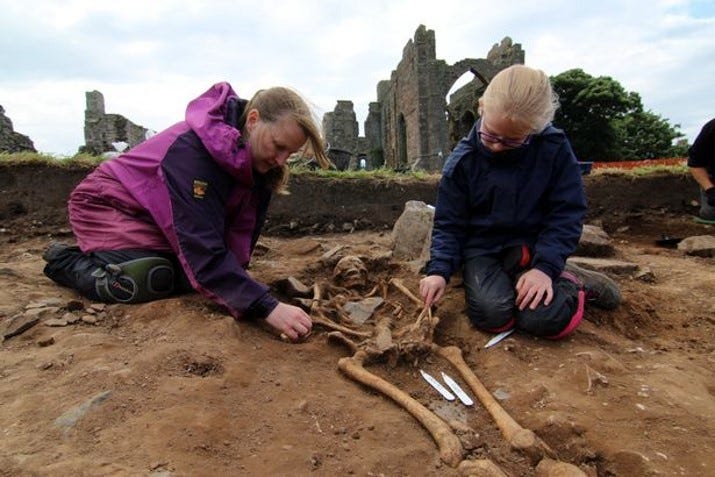THE CEMETERY AT HOLY ISLAND MONASTERY
On Britain's northern coast sits the Holy Island of Lindisfarne, where in 2016, a dig uncovered bone fragments which have been dated to the 8th century.
A recent discovery sheds more light on the lifestyle of the community that revolved around the large monastery.
An ancient cemetery was discovered during an excavation at Sanctuary Close which lies along the ruins of Lindisfarne Priory in Northumberland. The graveyard dates back to Anglo-Saxon times and is connected to a monastery that once existed on Holy Island in Northern Britain
Not only were entire human skeletons discovered, but also bones from seals and other animals that the inhabitants resourced from the North Sea.
It is believed the human bones belong to those who worked the monastery land as well as pilgrims who traveled to the island.
Along a ridge overlooking Sanctuary Close, an old church was found not too long before this discovery.
Bone fragments found earlier were tested and date back to the 8th century.
The monastery acted as a central point for the population living in the area, both the tenants and the nobility who owned land nearby.

In December, 2022, Lindisfarne with a history tied to the sea as evidenced by the excavations dating back centuries, is on a shortlist to ban the source of livelihood for those who live there.
It's not exactly clear the reason why Holy Island was placed on a list to become a Highly Protected Marine Area (HPMA). This strict fishing ban will destroy the village which has been inhabited for hundreds if not thousands of years.
This ban could accomplish what even the Vikings failed to do.
The factsheet justifying the ban would be "designed to achieve full natural recovery... of the biological communities present."
However fishing on Lindisfarne is presently done in a very ethical form. The island is already in a protected zone. The few fisherman who work there only catch crab and lobster, making sure to return any lobsters laden with eggs to the sea. There are no plans to trawl for lobster since there are conservation bylaws in place that do not allow this.
The ban will force the fishermen to leave, as there is no other type of work that can be done. With them will go their families.
The fishermen double as coastguards, not only for residents but for tourists as well. In 2021, they responded to 45 emergency calls.
If this happens, all who live and work there will be driven out then. It will just become a tourist trap, with perhaps a museum about the marine life and the exciting history of the coast.








